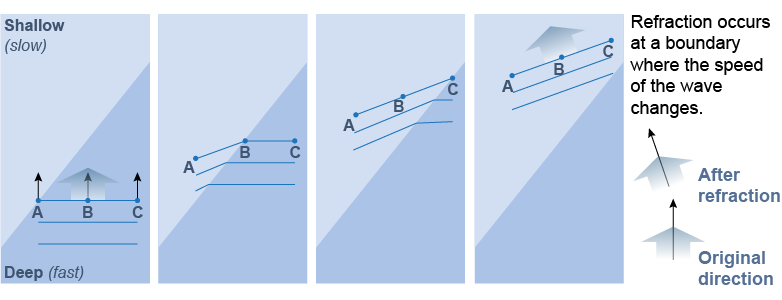|
 Some boundaries divide regions where conditions change, such as the depth of water. A plane wave in water that crosses a depth boundary changes its direction. This process is called refraction. Refraction is the process by which a wave changes direction as its wavefront is altered by passing through a boundary. A plane wave passing through a straight boundary remains a plane wave but changes direction as shown in the diagram.
Some boundaries divide regions where conditions change, such as the depth of water. A plane wave in water that crosses a depth boundary changes its direction. This process is called refraction. Refraction is the process by which a wave changes direction as its wavefront is altered by passing through a boundary. A plane wave passing through a straight boundary remains a plane wave but changes direction as shown in the diagram. 
|
Refraction occurs when the speed of the wave is different on the two sides of a boundary. Consider three points on the crest of a plane wave crossing a boundary between deep and shallow water. Water waves travel slower in shallow water compared to deep water. Point A reaches the boundary first and starts to move slower. Point B hits next and point C hits last. The wavefront over the shallow section has a different angle than the original wave. A wave moves in the direction perpendicular to the wavefront, and therefore the change in the wavefront causes a corresponding change in direction of the wave as it crosses the boundary. 
|

|
Refraction usually changes the wavelength as well as the direction. Note in the diagram that the wavefronts get closer together on the slow side of the boundary. This occurs because the frequency of the wave does not change. The same number of crests per second must enter the boundary as leave. If the speed v gets slower and the frequency f stays the same, then, according to the equation v = fλ, the wavelength λ must decrease. 
|
Refraction occurs with all types of waves, including transverse and longitudinal waves, and is important in many technologies. In optical systems, such as in cameras and telescopes, curved refracting surfaces bend light waves to create images. Ultrasound imaging detects the changes in tissue density within the human body by measuring the refraction of very high frequency sound waves. 
|
Which of the following wave characteristics remains unchanged whenever a wave refracts? - speed
- wavelength
- frequency
- direction

|
The answer is c, the frequency. The frequency remains unchanged even though the speed and wavelength change. The direction of the wave’s motion will also change unless the incoming wavefronts are parallel to the boundary. 
|

